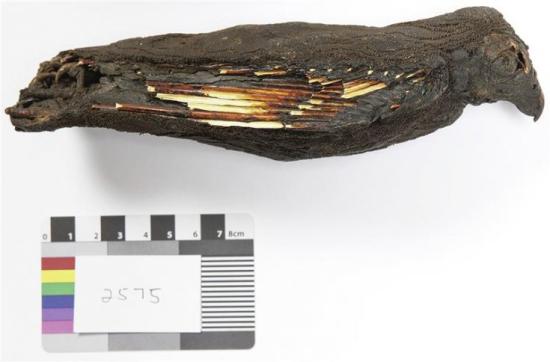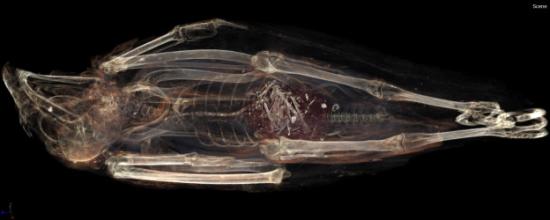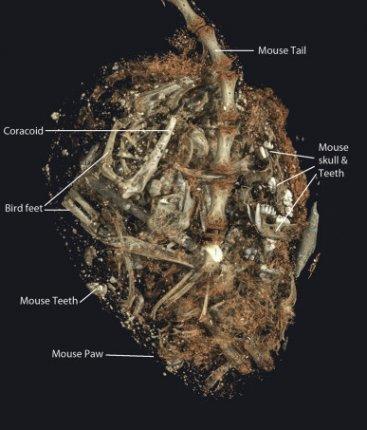Mummified raptor may have been bred for religious purposes
Source - http://www.eurekalert.org/pub_releases/2015-09/e-gk090315.php?
 The mummified kestrel choked to death on a mouse(Carina Beyer)
The mummified kestrel choked to death on a mouse(Carina Beyer)
3D imaging of a mummified kestrel that died due to forced overeating provides evidence that the ancient Egyptians bred birds of prey as offerings for the gods, according to a new study published in the Journal of Archaeological Science. The digital CT imaging revealed that the kestrel was force-fed its last meal - a mouse - suggesting it was kept in captivity.
 3D image of SACHM 2575 showing the tail of an animal extending through the bird's esophagus, crop and into its gizzard(Stellenbosch University)
3D image of SACHM 2575 showing the tail of an animal extending through the bird's esophagus, crop and into its gizzard(Stellenbosch University)
This is the first evidence to point to mass breeding of raptors as offerings to gods. The researchers behind the study, from the American University in Cairo, Stellenbosch University and the Stellenbosch Institute for Advanced Studies say their findings also have implications for the use of birds of prey in falconry for hunting.
Animal mummies were common in ancient Egypt and used in religious ceremonies, often as offerings. Millions of mummified animals have been found, most dating from around 600 BC to AD 250. Ancient Egyptians believed in many gods and associated different animals with them; raptors like kestrels were connected to the sun god Re.
"The idea of birds of prey being bred to the extent of being kept and force-fed is new," said Dr. Salima Ikram, Professor of Egyptology at the American University in Cairo and lead author of the study. "Until now, the sheer number of raptor mummies had been a mystery - did they catch or trap them and kill them, raid nests, or find them dead? Our results explain why they had so many: we now think it was because of active breeding."
In ancient Egypt, birds used as votive offerings were prepared by being gutted and dried, then dipped into molten resin and wrapped. However, sometimes the birds were not gutted, giving the researchers a chance to take a glimpse into one particular bird's life before it died.
The researchers carried out a virtual autopsy on a bird mummy from Iziko Museums of South Africa in Cape Town. The bird mummy, SACHM 2575, was scanned using CT imaging and the team created 3D images of the bird. Based on morphology, limb measurements and beak shape, they established it was a European kestrel (Falco tinnunculus).
Since the bird had not been gutted prior to mummification, they could also look into its digestive tract to see what its last meal had been. They found the tail of a young house mouse (Mus musculus), which appears to have caused the kestrel to choke to death. Looking further into the gizzard and stomach, they found other mouse fragments, including 27 loose teeth, suggesting that the kestrel had eaten more than one mouse earlier in the day. They also found parts of a small sparrow.
 The contents of the kestrel's stomach(Stellenbosch University)
The contents of the kestrel's stomach(Stellenbosch University)
"This was one of the most entertaining and exciting bits of research to do - when we saw how much the kestrel ate and how it choked, we suddenly had an idea about how the ancient Egyptians managed to mummify so many raptor and the implications about wild animal husbandry and the possibility of falconry being practiced in ancient Egypt," said Prof. Ikram.
"We know raptors were religiously important but it's interesting to think about the role they may have had in falconry. It's also interesting that Egyptians were exerting so much thought and control over nature and that their aptitude with wild animals is considerable."
The findings open the door to further work to distinguish the different breeding groups by analyzing the DNA of the raptors and determining their sex. The researchers say this will provide a deeper understanding of the role of raptors in ancient Egypt and explain how the Egyptians saw nature and their role in it.
"Fatal force-feeding or Gluttonous Gagging? The death of Kestrel SACHM 2575" by Salima Ikram, Ruhan Slabbert, Izak Cornelius, Anton du Plessis, Liani Colette Swanepoel, Henry Weber (doi: 10.1016/j.jas.2015.08.015). The article appears in Journal of Archaeological Science, Volume 63 (November 2015), published by Elsevier.